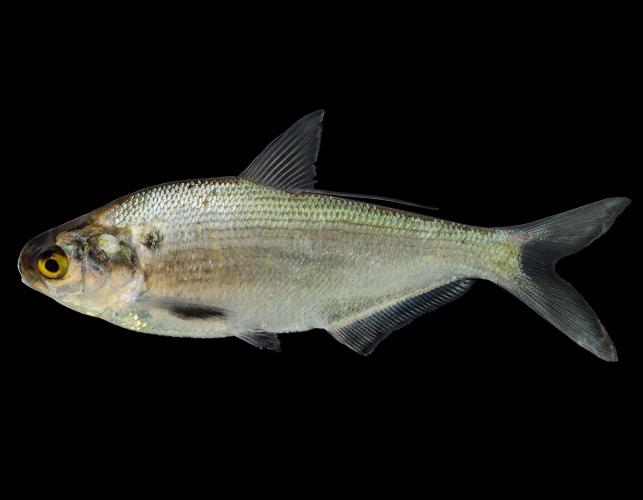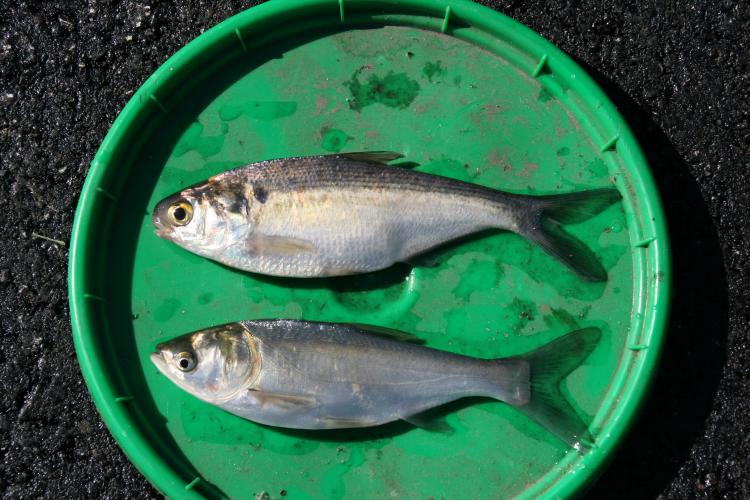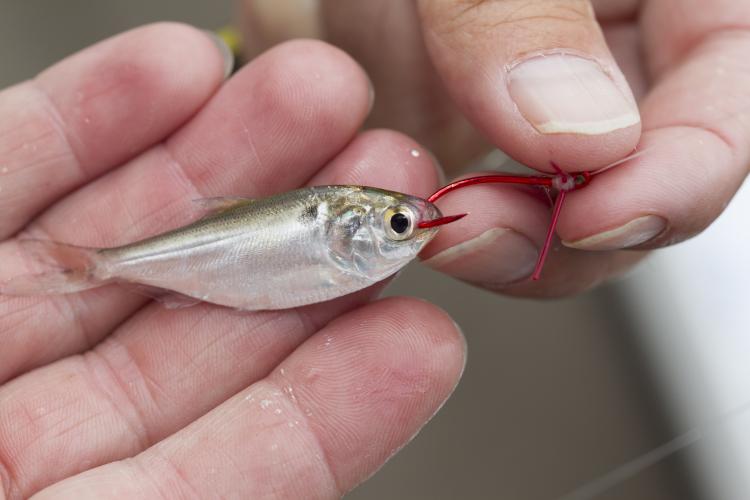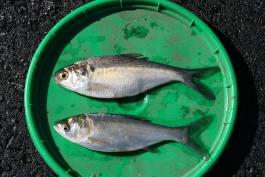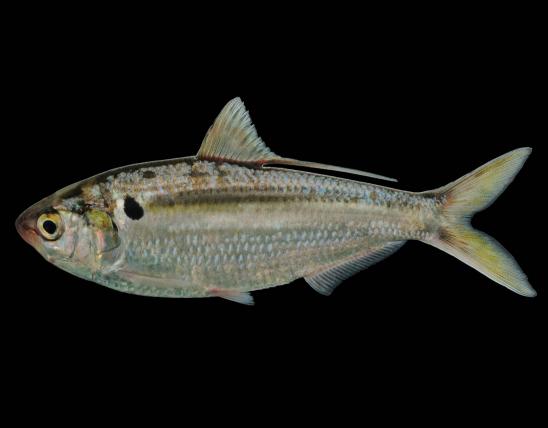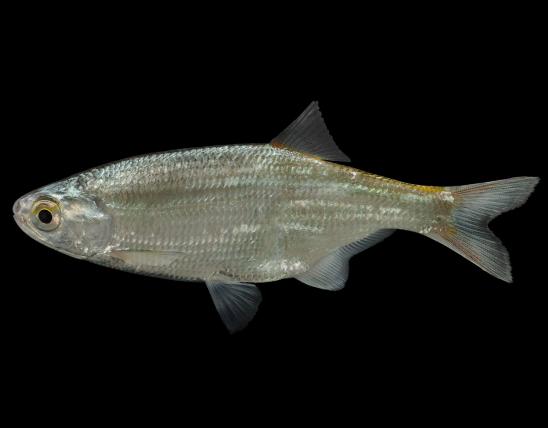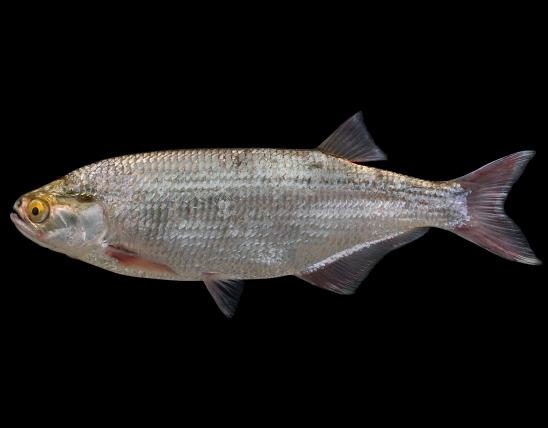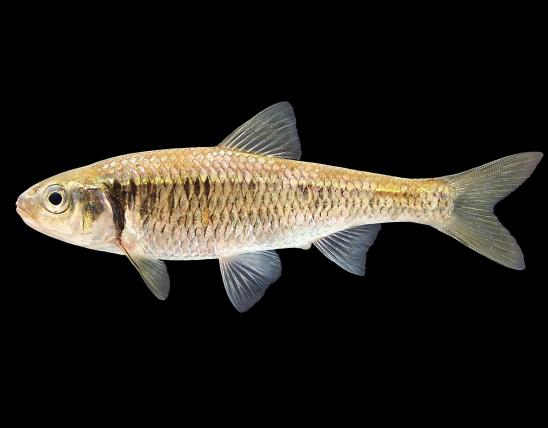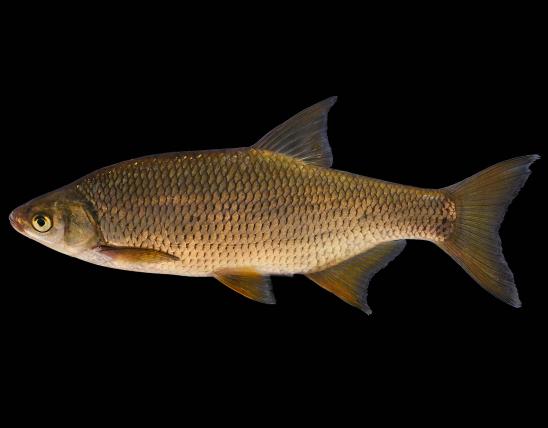
Herrings and shads, as a group, are silvery, flat-sided fish, easily recognized by the row of sharp-edged, spiny scales (or scutes) along the midline of the belly. These scutes are readily apparent when you rub your fingers forward along the fish’s belly.
The gizzard shad is a silvery, moderately deep-bodied herring with a large lustrous dark or purple spot (may be faint in adults) just behind the upper end of the gill cover. The tail is deeply forked, the belly keel-shaped. The last ray of the dorsal (top) fin is prolonged into a long, slender filament. Anal fin rays usually number 29–35. The mouth is small, the lower jaw not projecting beyond the tip of the snout. Lateral line scales usually number 55 or more. In living specimens, the tail fin is not yellow.
Upperparts are silvery blue, grading to silvery white on the lower sides and belly. The upper sides have several horizontal dark streaks. There is a large, lustrous purple spot just behind the upper end of the gill opening, but this spot may be faint or absent in large adults. The fins are dusky, without prominent yellow colors.
Similar species: Four species in the herring family are recorded for Missouri:
- The threadfin shad (D. petense) is most similar to the gizzard shad. Both have the last ray of the dorsal fin elongated into a long, slender filament, and both have a dark spot behind the upper end of the gill opening. However, the threadfin shad has the lower jaw projecting beyond the tip of the snout; its anal fin rays usually number 20–25; its lateral line scales number 50 or fewer; and in life, its tail fin is bright yellow. Also, threadfin shad are generally smaller, rarely exceeding 6 inches in length.
- Both the skipjack herring and the Alabama shad may be separated from the gizzard shad and threadfin shad by their lack of an elongated, filament-like last dorsal fin ray and their lack of a dark spot behind the upper end of the gill opening. Also, the principal rays of the dorsal fin usually are 16 or more.
Members of the herring family might be mistaken for the mooneye and goldeye (which are in a different family), but herrings have the following key characters: The dorsal fin is far forward of the anal fin. The head is without scales, but the body is covered with thin, smooth-edged (cycloid) scales that are easily dislodged. The lateral line is absent. A small, triangular projection (an axillary process) is present just above the base of the pelvic fin, and the eyes are partly covered by transparent membranes (adipose eyelids).
Total adult length: commonly 9–14 inches; weight: commonly a pound or less. Maximum is about 20 inches and 3 pounds, 7 ounces.

Occurs at least occasionally in every major stream system. Is most abundant in reservoirs and large rivers.
Habitat and Conservation
The gizzard shad is one of the most common and widely distributed of the larger Missouri fishes, occurring at least occasionally in every principal stream system of the state. It is most abundant in the Missouri and Mississippi rivers, their overflow waters and lower reaches of their tributaries, the lowland ditches of southeastern Missouri, and large reservoirs statewide. It is least abundant in streams of the central Ozarks and prairie-region streams of northwestern Missouri.
The gizzard shad inhabits a variety of quiet-water habitats, including natural lowland lakes and ponds, artificial impoundments, and the pools and backwaters of streams and rivers. It occurs in both very clear and moderately turbid waters but prefers those where aquatic productivity and fertility are high. Decreased turbidity of the Missouri River, following the construction of dams upstream, has been favorable to this species. It avoids streams with very high gradients and those that lack large, permanent pools.
This fish is most active at dusk and at night. The gizzard shad travels in large, constantly moving schools near the water’s surface and frequently leaps clear of the water or skips along the surface on its side, earning it the common name "skipjack."
Food
Most members of the herring family feed on plankton. This species is omnivorous, feeding on plankton, algae, small aquatic insect larvae, and detritus. Like the closely related threadfin shad, the gizzard shad is primarily a filter feeder. However, gizzard shad are primarily bottom feeders, while threadfins feed mostly in open water.
The first foods of young gizzard shad are microscopic animal life, but they soon begin eating free-floating algae and small aquatic insect larvae.
The mouth shape is a clue that gizzard shad are bottom feeders. Studies in two Ozark reservoirs showed gizzard shad eating organic detritus. They got much of this material by grazing over logs, the stems and leaves of aquatic plants, or other submerged objects. They can feed on zooplankton by rapid sucking or pumping actions that remove food items from the water by filtering them through the long, closely set gill rakers.
Mechanical breakdown of the food occurs in the muscular stomach or "gizzard," which contains sand to facilitate digestion.
Life Cycle
Spawning typically occurs from early April through May, most often in the shallow water of protected bays and inlets. The eggs and milt are released by a mixed school of males and females as they roll and tumble about each other in a mass near the water's surface. A single female may produce more than 250,000 eggs.
After spawning, the adhesive eggs sink to the bottom and attach to the first object they touch. Eggs hatch in 2–7 days, depending on water temperature during development. For the first 2 days after hatching, they persistently swim upward and sink back for about the same distance. As with other herrings, larval gizzard shad are slender, transparent fish, quite different in appearance from the adults. They acquire the typical adult shape by the time they are 1¼ inches long.
Young gizzard shad are abundant along the shore of the Missouri River in late May and June. Growth varies with the productivity of the water and other factors. In Missouri streams, gizzard shad are about 5 inch long by the end of their first year of life. When 3 years old, they average about 11 inches in length.
A few gizzard shad can live 10 or more years, but 4–6 years is the usual lifespan. They reach maturity their second or third year of life.
Human Connections
Fisheries specialists have long debated the role of gizzard shad. It is prolific, producing numerous young that are used extensively as food by game fishes. But growth is rapid, and soon the adults are so large that they are relatively immune to predation. At times adults are so numerous that they are thought to compete for food and space with more "desirable" species. In Missouri's large reservoirs, the importance of the gizzard shad as forage seems to outweigh its nuisance qualities: It forms a short, efficient link in the food chain of white bass, crappies, and largemouth bass, and the well-being of those species seems to depend to a large extent on fluctuations in abundance of the gizzard shad.
The northern pike is like a larger version of redfin (grass) and chain pickerels. It is stocked in Missouri reservoirs in part to effectively control the large stocks of carp and gizzard shad present in those waters.
Because of its specialized food habits, the gizzard shad is taken on hook and line only by accident; its soft, tasteless flesh is of little value as food for people.
Gizzard shad is sometimes used as cut bait for jug or set-line fishing along the Mississippi River.
Ecosystem Connections
Shad form a short, efficient link in the food chain between the tiniest organisms (such as algae and zooplankton) and larger fish as well as many other fish-eating animals: herons, seagulls, cormorants, watersnakes, raccoons, and many, many more. The survival of these animals depends a great deal on the numbers of gizzard shad.
The pointed scutes along the bottom keel of shad and other herring are one reason many fish-eating predators flip a fish around before swallowing, so that the shad goes down headfirst. In the process of flipping the shad around, the predator might accidentally drop the shad, and the shad might escape. In this way, the scutes offer a survival advantage to the shad.
The vast number of eggs and larvae produced by gizzard shad are eaten by a tremendous variety of animals.
Hungry schools of plankton-feeding shad help to reduce numbers of microscopic animals, including larval insects, which may also have a very high reproductive capacity.
